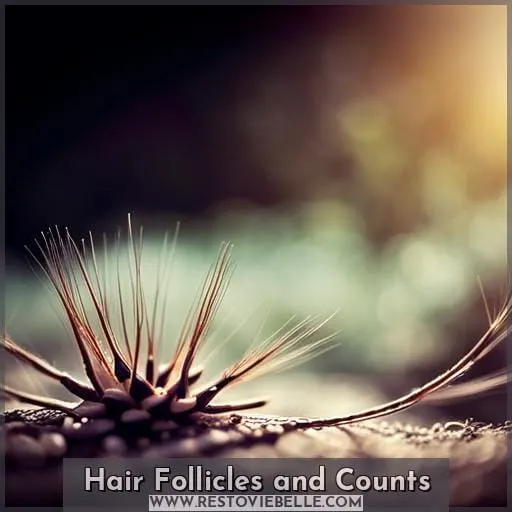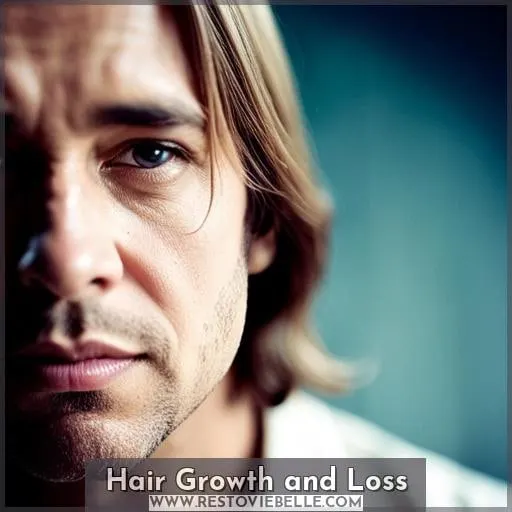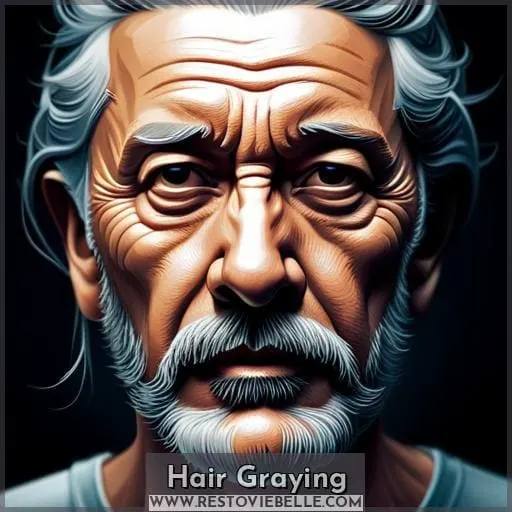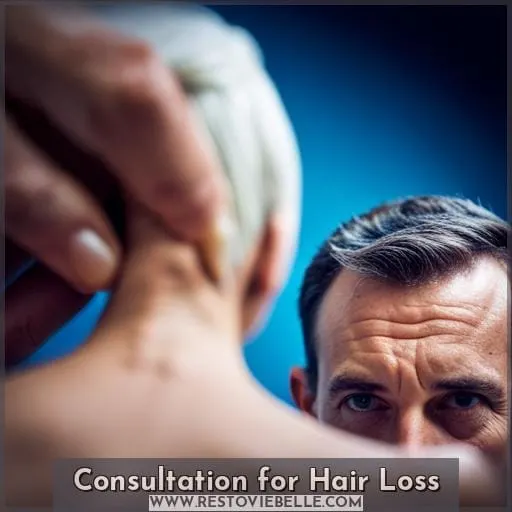This site is supported by our readers. We may earn a commission, at no cost to you, if you purchase through links.
 Have you ever stopped to marvel at the complexity of your hair? From its texture and color, to its ability to act as an insulator against heat or cold – it’s a truly remarkable part of the human body.
Have you ever stopped to marvel at the complexity of your hair? From its texture and color, to its ability to act as an insulator against heat or cold – it’s a truly remarkable part of the human body.
But how many hairs are we actually talking about? On average, each person has between 80,000 and 120,000 strands of hair on their head. This figure can range depending on age and gender. For example, men often have more hairs than women do due to increased density in certain areas like facial hair growth.
In this article, let’s explore the fascinating facts behind human scalp follicles and what they mean when it comes to understanding our own individual locks!
Table Of Contents
Key Takeaways
- An average person has 80,000-120,000 head hairs.
- Men generally have more hairs than women.
- Blondes have approximately 140,000 hairs, brunettes have 110,000, and redheads have 90,000.
- The hair on a human head grows at a rate of 0.5 inch per month, or 6 inches per year.
Hair Follicles and Counts
You may be surprised to learn that the average human scalp has around 100,000 hair follicles at birth and an adult body can have up to 5 million. These follicles are evenly distributed across the skin, except for on palms and soles.
However, men tend to have a few hundred thousand more than women. Moreover, blondes typically have 140,000 hairs, while brunettes usually have 110,000. Redheads have 90,000, and brown/black hair has 100-110k. The density of hair follicles is 800-1290 per square inch or 124-200 per square centimeter.
Each strand is able to withstand 1/4 pound strain and becomes 12-18% heavier when wet, yet it stretches 30% longer compared to dry hair.
To sum it up, the hair growth rate is about 6 inches annually or 0.5 inch monthly, with males growing faster than females. Hair shedding ranges from 50-100 strands daily, which could indicate the onset of hair loss in terms of volume as well as coverage area.
Number of Scalp Follicles at Birth and on Adult Body
At birth, you have around 100,000 scalp follicles — that’s up to five million on an adult body! Genetics influence the number of hairs you’ll get from your parents and how thick they will be. Follicle depth plays a role in hair texture, while split ends occur when there is not enough scalp hydration.
Hair color can range from red to black; however, blondes tend to have more than other colors, with an average of 140,000 strands. The density of hairs per square inch or centimeter varies greatly and can affect the overall look of your mane.
Distribution of Follicles and Differences Between Men and Women
You’ll notice that follicles are spread evenly across the body, except for on your palms and soles, with men having a few hundred thousand more than women.
Hair growth varies from person to person; shedding 50-100 hairs per day is normal. Graying rate increases 10-20% after age 30 while hair strength can withstand 1/4 pound of strain and become 12-18% heavier when wet.
Variations in density cover 800-1,290 hairs per square inch or 124-200 hairs per square centimeter depending on gender and color. Blondes have an average of 140k strands, brunettes have 110k strands, and redheads have 90k strands.
An appropriate hair care routine will keep this balance stable over time!
Hair Counts Based on Hair Color and Density
Discover the incredible range of hair counts among different colors and densities – from blondes to brunettes, redheads to browns. Hair density varies greatly depending on color, typically 800-1,290 hairs per square inch or 124-200 per square centimeter.
Blondes often have 140,000 follicles, while brunettes average 110,000 and redheads 90,000, with brown/black having between 100k-110k strands. UV radiation causes an increase in graying as we age – 10%-20% more each decade after 30 years old! We also shed 50-100 hairs daily, but our locks can withstand 1/4 pound of strain and are 12%-18% heavier when wet, plus they stretch up to 30%.
Hair Growth and Loss
Are you curious about how much hair is on a human head? Understanding the rate of growth, differences between genders, typical shedding patterns, and signs of loss can provide insight into this question.
On average, human hair grows 6 inches per year for both males and females; however, male hair tends to grow faster than female. Shedding up to 100 hairs a day is normal, but any more than that could be an indication of potential loss.
Additionally, each strand has its own strength as it can withstand a 1/4 pound strain while being 12-18% heavier when wet, with the ability to extend 30% longer in length.
Rate of Hair Growth and Differences Between Males and Females
On average, you grow half an inch of hair each month – with males growing slightly faster than females. Lifestyle changes and genetic factors can play a role in how quickly your hair grows, as well as the texture and maximum amount of hairs on your head.
Treatments such as baldness therapies or products like shampoos aim to help slow down the transition stage from resting to growth phase for healthier-looking locks.
The Pigeonhole Principle states that no matter how many people there are in this world, some will have the same number of follicles due to its finite nature.
Ultimately, it’s important to keep track of your individual needs when it comes to maintaining healthy tresses!
Normal Hair Shedding and Signs of Hair Loss
Beneath your crown, the normal shedding of hairs may be replaced by dramatic thinning and coverage loss. Excessive heat styling, strong hair products, or genetic factors can all lead to this kind of balding pattern.
Keeping a healthy scalp is key – seek help from an in-person consultation if you notice more than 100 strands accumulating in the drawers daily.
Hair loss also plays a psychological role; it’s important to consider not just scalp coverage but overall hair shedding as well for balanced results that suit individual needs best.
Consider the toll-free line 844-GET-HAIR or the direct questions option at +1 561 394 0024 to get started on restoring confidence and wellbeing today!
Hair Strength and Ability to Withstand Strain
You can rely on your strong hair to hold up against everyday wear and tear, as each strand is capable of bearing a quarter pound of strain. Hair types, follicle size, texture, and color all play a role in its strength. Thicker strands are stronger than thinner ones, while people with certain hair colors tend to be more resilient.
Human body hair also provides protection for the skin beneath it – not only from external forces but also internal ones like temperature regulation. This evolutionary trait has been essential for humanity’s survival throughout history and continues to serve us today! With different levels of thickness or thinning depending on age or gender, we can trust our bodies’ natural defenses when it comes to protecting ourselves against any force that might try to damage us.
Hair Graying
After age 30, graying hair increases 10-20% per decade – so in your 40s, you can expect about double the amount of gray.
There are many causes for this phenomenon, including aging factors such as hormones and lifestyle choices like sun exposure or smoking. Hereditary traits and individual hair types also play a role when it comes to graying hair.
According to Dirichlet’s Principle of Pigeonholing, at least 8,000 people have the same natural number of hairs on their head due to its maximum 1 million count potential combined with an average between 90–150 thousand hairs amongst humans.
This theorem is complex, yet it has interesting consequences that allow us to understand how our environment affects our physical appearance even down to the smallest details, like having identical amounts of strands upon a person’s scalp, regardless if they’re from opposite sides around the world or living just next door!
Consultation for Hair Loss
If you are experiencing hair loss, there are several options available for seeking consultation. You can opt for virtual long-distance consultations or in-person visits to the office. To get started, contact 844-GET-HAIR toll-free or +1 561 394 0024 and ask your questions directly.
Options for Seeking Consultation for Hair Loss
For those experiencing hair loss, consultation options range from virtual long-distance to in-person office visits and include toll-free support.
- Hair restoration solutions
- Scalp health analysis for hereditary baldness
- Taking supplements for optimal results
- Hair transplant procedures on a spherical surface
- Professional guidance from Dr. Bauman’s team of experts.
Consultation will help determine the best course of action based on your individual needs and provide a rounded-up value regarding wet hair properties if applicable.
It’s important to speak with an expert about your unique situation so you can make an informed decision about how to move forward with treatment or prevention strategies that fit within budget constraints while achieving desired goals.
Virtual and In-person Consultation Methods
Discovering the right consultation method for your hair loss can be daunting – a virtual or in-person approach? Choose wisely, like an eagle soaring through a clear sky.
Diagnosing causes and hereditary factors is best done face to face with a professional who can assess thinning areas, scalp health, and discuss topical solutions. In-office visits also allow experts to evaluate lifestyle changes that may improve results, such as dietary supplements or reducing stress levels.
Virtual consultations are also available if time is limited; these provide access to specialists from anywhere in the world, including during soccer games! Distribution of points while sensation detection helps identify simple systems used for hair volume restoration without having ever met the patient before!
Contact Information for Hair Loss Consultation
Reach out today for a hair loss consultation with our experts by calling 844-GET-HAIR toll-free or +1-561-394-0024.
Hair shedding, thinning, decreased volume, and coverage are all signs of hair loss.
Learn about the average number of hairs on your head – from blondes to redheads – as well as basic assumptions regarding temperature regulation and sweat evaporation that affect your overall hair strength.
Our team can help you understand how many hairs are on your head based on color counts, density measurements, and growth rate data points specific to you.
Take control of your life today with a virtual or in-person consultation!
Math Principles and Hair Count
Analyzing the math principles involved in hair count estimations, you can apply the Pigeonhole Principle to understand that with 8 billion people on Earth, it is likely that at least 8,000 of them have the same number of hairs.
On average, a person has 90,000-150,000 hairs, and a maximum of 1 million; therefore, some individuals must share similar counts.
Application of the Pigeonhole Principle to Hair Count
You can use the Pigeonhole Principle to estimate how many people in the world have approximately the same number of hairs on their head, for example 8,000. It is based on hair fibers and follicle shape, as well as hair colors. Blondes average 140,000 hairs, while brunettes have 110,000 and redheads have 90,000.
Hair growth rate also affects it. Males grow faster than females, and an adult has 5 million follicles over their body, except palms or soles.
Estimated Number of People With the Same Hair Count
Based on mathematical principles, as many as 8,000 people may have the exact same number of hairs on their head. Hair types, follicle sizes, and textures all play a role in determining hair count.
- The average person has 90k-150k hairs.
- The maximum possible number of hairs is 1 million.
- Men tend to have more hairs than women.
- Blondes average 140k hairs, brunettes 110k hairs, and redheads 90k hairs.
- Graying increases 10–20% per decade after age 30.
Explanation of the Math Principles Involved in Hair Count Estimation
Using the Pigeonhole Principle, it’s a safe bet that at least 8,000 people on this planet share your exact hair count – so don’t worry if someone else has the same ‘do as you!
This is due to global trends in follicle size and hair types. Accurate estimates can be made based on an individual’s specific structure and density of their hairs, resulting in a high accuracy rate.
These calculations are possible by recognizing patterns between different colors, lengths, and textures, including differences between men and women across all ages.
Frequently Asked Questions (FAQs)
What are the best ways to prevent hair loss?
To prevent hair loss, consider reducing stress levels, eating a balanced diet, and using gentle products. Additionally, ensure you have regular scalp massages to stimulate circulation and apply oil treatments for hydration.
How can I keep my hair healthy and strong?
Take good care of your hair by washing it frequently and using quality products. Use natural oils to nourish and protect, avoid over-styling with heat tools, brush gently, wear a hat in the sun. Eat nutritious foods for healthy growth; drink plenty of water; get enough sleep to promote follicle health.
What are the causes of premature graying?
Premature graying is caused by genetics, hormones, stress, and nutrition. There is no known way to prevent it, but eating a healthy diet and managing stress can help slow down the process.
Are there any natural remedies to promote hair growth?
Yes, natural remedies can help promote hair growth. Try massaging your scalp with essential oils like lavender or rosemary to stimulate the follicles. Eating a balanced diet rich in protein and vitamins A, B12, C, and E will also nourish your strands from within.
Lastly, maintain good hygiene by washing regularly and avoiding tight hairstyles that pull on the roots of the hair.
Is there a way to estimate the amount of hair I have?
You can estimate the amount of hair you have by looking at averages for your hair color. Blondes typically have 140,000 hairs, brunettes have 110,000, and redheads have 90,
Conclusion
Overall, it’s clear that humans have an average of 90,000-150,000 hairs on their heads, with a maximum of 1 million. Men generally have slightly more follicles than women, but the number of hairs can vary depending on hair color, density, and other external factors.
Through the application of the Pigeonhole principle, we can estimate that at least 8,000 people have the same number of hairs on their heads.
So, when it comes to the question of how many hairs are on a human head, the answer may not be straightforward. However, the facts and averages presented in this article can provide a solid understanding of the average amount of hairs present on a human head.










